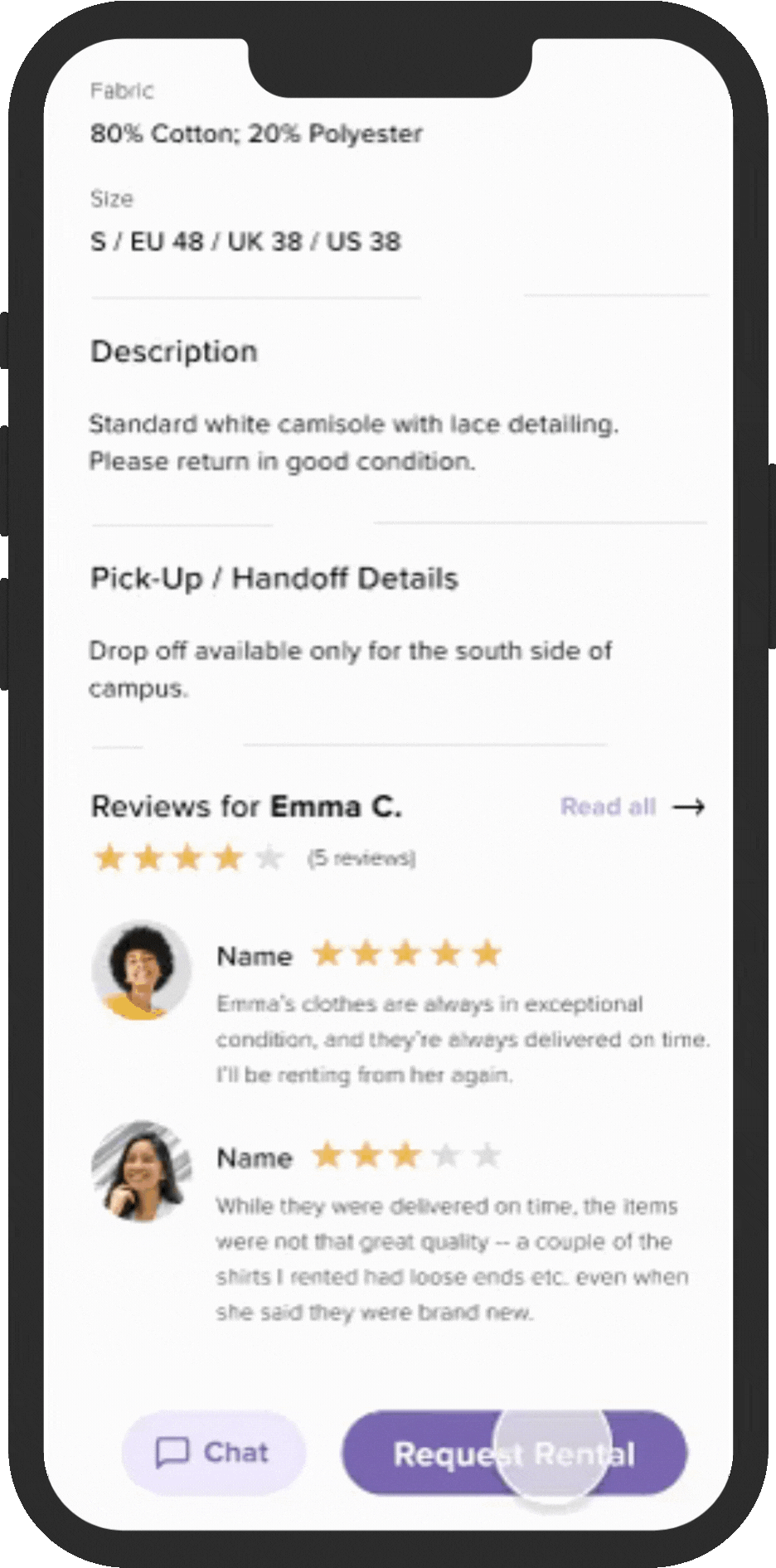DormThreads
A comprehensive rental marketplace for all of your shopping needs.

Don't want to buy a whole new outfit just to wear it once? DormThreads advocates for sustainable consumption by allowing students to rent clothing from fellow peers on campus.
role
product designer
timeline
10 weeks, Spring 2024
tools
Figma
team
Nicole Gunawan
background
In a class called DSGN 241: Wireframing & App Design, we were tasked to create a solution to any existing problem that a college student may face. The class was entirely focused on the end stages of the product lifecycle.
problem

Not all students can afford to buy clothes they will only use once...
Even though lots of events on campus expect individuals to have certain articles of clothing (think networking dinners, career panels, and end-of-semester celebrations...)
This hinders individuals from reaping the full benefits of the experience in which it is important to be dressed in a certain manner.

.png)


proposed flow
A seamless digital rental experience for customers & vendors.
The app offers intuitive navigation systems, safe transactions, and structured return policies to ensure everything gets returned on time.

design
wireframing
Exploring the customer user flow, to integrate browsing, renting and returning systems.
Select features were prioritized in order to streamline the creation of a high-fidelity prototype in a limited period of time.


prototyping
Redefining and finalizing details according to user feedback.
The placement and layout of product cards were altered to adapt to responsive screen sizes, and labels within item profiles were created to prioritize the communication of essential information (i.e. sizing & whether an item was used or new).
Login screen
Users are able to input their username & password, as well as click the forgot button in case they aren’t able to log in.
.png)

View item
-
Users can view information about an item, including the timeframe in which it’s available for, & price per day
-
They can also view the item owner's overall rating & reviews
-
Item owners are contactable through a built-in chat feature
Browse
-
Users can search for items they want to rent and subscribe to certain closets
-
There is also a filter system that allows users to browse by availability, item type, price, size, hashtags etc.


Rent
-
Users can easily request to rent an item by stating their intended rental length and reasons for renting.
-
If the request is approved by the item owner, the full amount is automatically deducted from the user's account.
Rentee profile
Rentees are able to view their rating, the items they’re currently renting, as well as pending rental requests to be approved by the item owner.
.png)
next steps
Preliminary usability testing & re-iteration of the prototype.
As this was a course that focused entirely on UI, I was unable to perform any user research. Therefore, I think it would be imperative for me to test the functionality of the prototype -- including the effectiveness of each feature in allowing the user to rent items from other users.
Additionally, I think it would be important to conduct an A/B test to identify the personal recommendation categories that would be most useful to users while browsing, as well as explore different methods of displaying information other than cards, as my current design limits the amount of information displayed to the user.
Finally, I'd like to expand on the task flow for vendors, including what their experience would be like uploading their items and accepting rental requests. It would also be necessary to expand on the return experience, and outline the security measures needed to be set in place to mitigate risks and ensure that the rented items are returned safely to the original owner.
learnings
Through this project, I was able to take charge of the entire prototyping process & learn how to troubleshoot.
All of my past projects have required me to work as part of a team, delegating certain tasks to each member. Whilst a great opportunity to learn from others, it has limited my development of a well-rounded skill set in Figma.
Working alone however, has allowed me to push past my comfort zone, as I was required to know the ins-and-outs of making a fully functional product. With this experience, I've grown more comfortable with nested components and frames, constraints, instances and other key elements of Figma.
Even though I did run into more issues than if I worked as part of a team (i.e. there were situations where I could not alter child instances, horizontal scrolling did not function, and my frames did not scale well), I learnt how to debug effectively, examining layers to identify how the components were nested, and taking initiative to tap into online resources.
end product
_edited.png)
